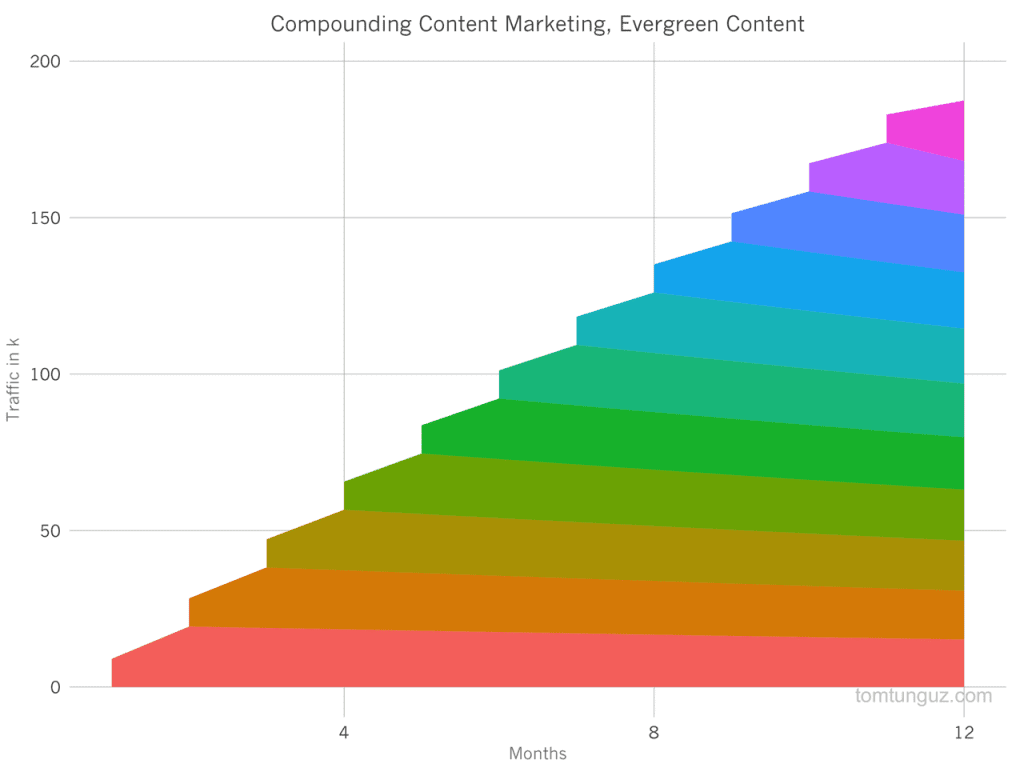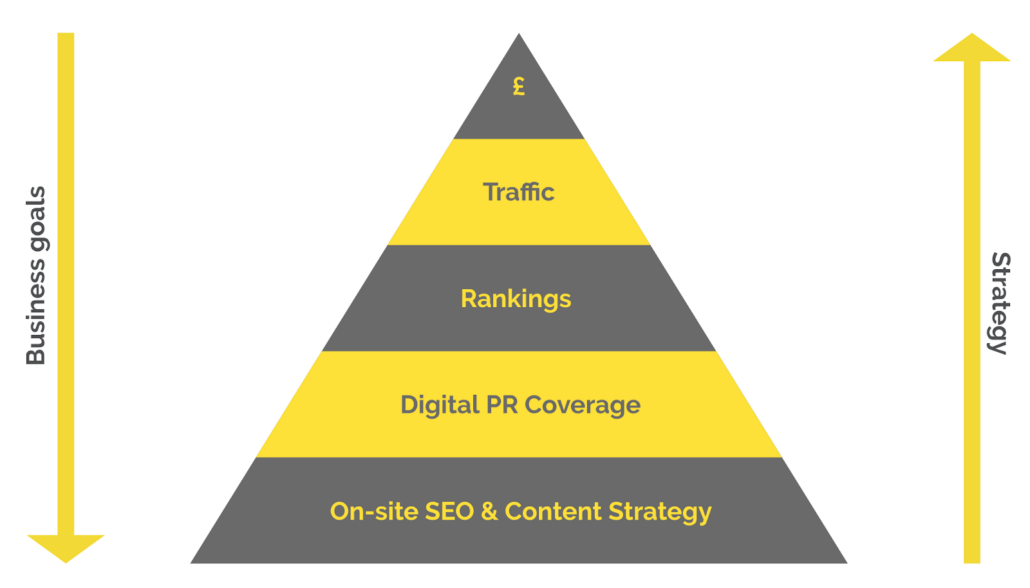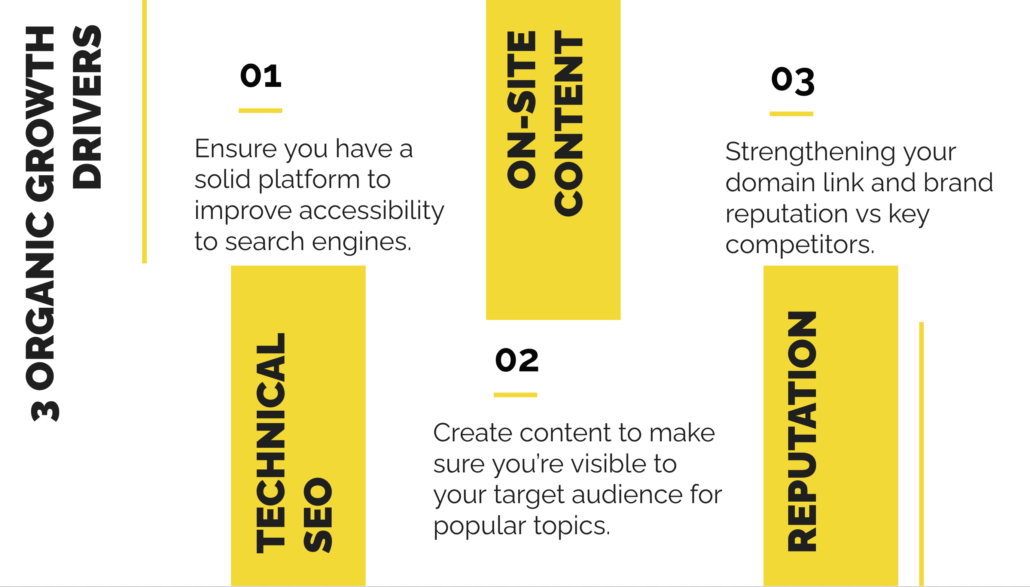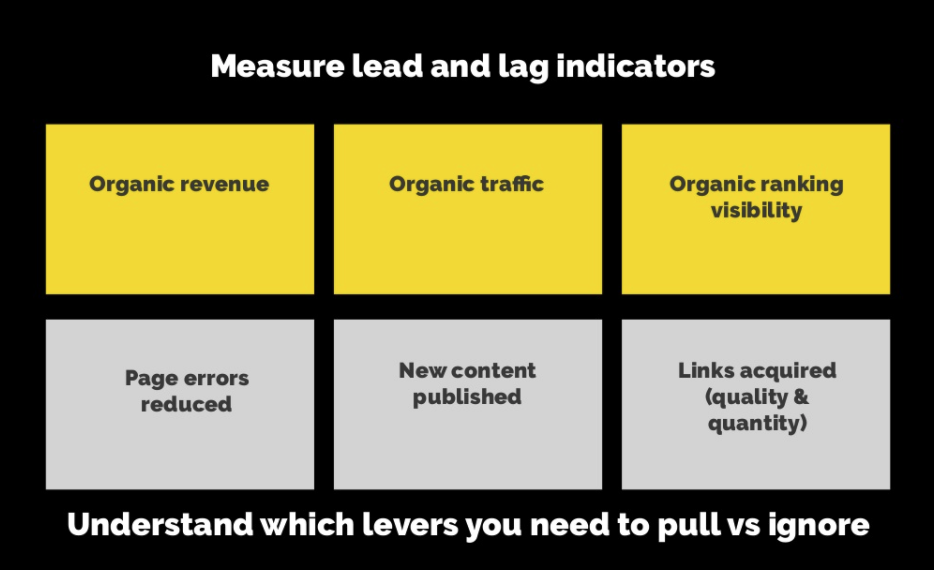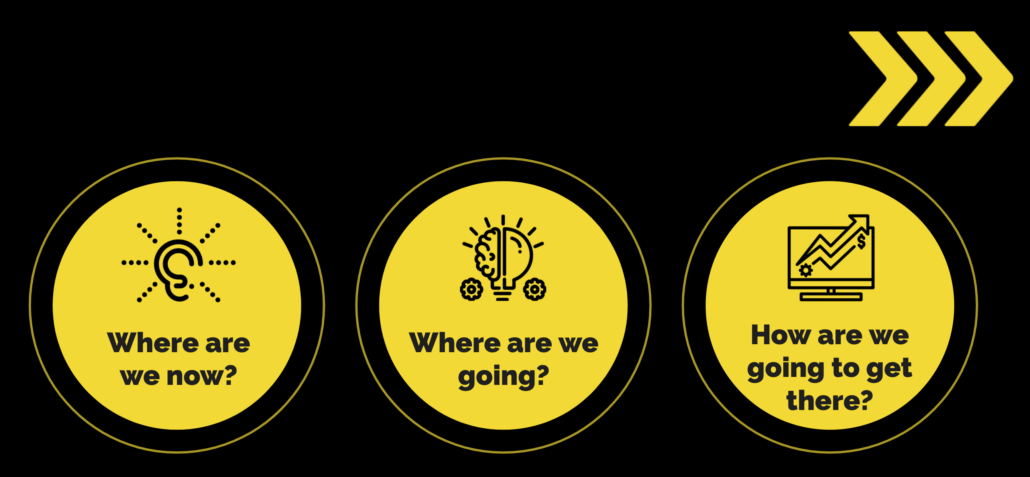If you don’t know where you’re going, don’t complain about where you end up.
This is something a mentor of mine has told me a few times. It’s a lesson that applies equally to business, life and SEO.
Let’s set the scene. We’ve all been there. That client meeting where you’ve done a great job; showed them you’ve fixed 983 issues, gained rankings for 102 keywords, secured 52 links etc. All to get asked “so what”?
It’s disheartening. What went wrong? Why didn’t they get it?
It’s not you, it’s me… If they don’t understand the importance of what you’re doing in a way that relates to their business. That’s your problem to fix.
In a recent podcast episode, David C Baker said that SEO is the least sophisticated part of the marketing world. Having been involved in SEO since 2003, I’d like to strongly disagree. I think we’ve come along in terms of growing up as an industry, but equally, if I’m honest, I get where he’s coming from.
When you analyse other channels like paid search/advertising or conversion optimisation, you’re paying money for an investment in growth. That’s exactly how it should be in SEO, but I fear that often people get distracted by SEO KPIs (or ‘I’s as I prefer to call them; they’re indicators you’re on track but often they’re not ‘key’).
SEO is an investment in business growth. Especially in a tough financial climate, but it should be the same strategy whatever the wider context. That means providing a measurable uplift in organic revenue and profits that can be tied back to your efforts.
Sometimes SEO can lose sight of that. I wrote an article a few years ago on how short-termism is killing marketing. When you’re making a business decision how often do you question what will be the consequences of your decision five or ten years down the road? I suspect if we’re honest with ourselves, the majority would confess they don’t think about the long-term impact nearly enough.
I see this every day in SEO. People want one advanced SEO tip / silver bullet or a creative campaign which can cause excitement. But often what they want and need are two different things.
The next hit and spike is exciting but is that taking you closer towards the long-term objective, or are you resetting each time and you’re back to where you started?
In a similar way to building habits, you shouldn’t just be doing one and then moving onto the next, you should be ‘habit stacking’ to build up collectively over time. This is how it should look from an SEO or content marketing perspective:
Image from this excellent post on Marketing Insider Group.
The best case studies in my career have been ‘slow and steady wins the race’, strategies where growth is gradually compounding over time.
The big spikes can be exciting on a monthly basis but they have to turn into something more meaningful in the long term. The trap to avoid is judging too early, if you overlay the above with campaign spikes and see success after 3-6 months, it’s easy to assume the short-term approach is much more successful. But what if that fades away quickly and returns to zero?
The biggest opportunity in SEO today in my view, is the ability to see the wood for the trees. I would argue that what is really needed is a shift in mindset, to help understand the bigger picture. Take a step back and frame the problem in the right way, while being patient enough to create a plan to achieve your desired outcome in the long-term.
Short-term impact, long-term success. To win in SEO, primarily you need to want to win long-term. That requires patience and confidence you’re doing the right thing.
To grow you need intention. Just doing stuff and seeing where you end up doesn’t cut it, you need to understand where you’re going, understand where the opportunity and obstacles lie and shape a plan around putting everything into making it a success.
Instead of a scattergun approach, be laser focused. SEO isn’t a hit and hope strategy or game of throwing stuff against the wall and seeing what sticks.
The following framework breaks down how I typically approach this:
Where are we now?
This step sounds so obvious and it is. But that’s what makes it so surprising that it’s so often overlooked. You might be excited and want to jump straight in but take time to do the following first.
1.Current performance – review your analytics:
- What % is organic search vs overall traffic/revenue? This excellent article shows that often it’s 55-75%. That’s huge and needs to be treated seriously.
- What are your top-performing pages? Is there an 80/20 rule you might be missing? 80% of organic revenue is driven from 20% of key pages that you can really double down on improving.
- Are you confident in the data you have? Is conversion tracking or attribution modelling setup probably? We’re in a world where we all talk about big data and make data-driven decisions, yet quite often there’s fundamental issues in how we collect that data. Good decisions from bad information are bad decisions. and they can set you back much further than you think.
2. What’s working well vs what isn’t?
- Audit your performance across the 3 organic growth drivers to understand where the priorities for improvement are, the value of those changes, and if there are any skeletons in the closet that need removing, disavowing or burning.
- Technical SEO auditing – looking from page speed optimisation gains, to improving site crawling and indexing, though to geo-targeting handling and CMS platforms.
- On-site content – you should fully understand your content’s existing performance before you create anything new. Often you’ll find duplication, a need for consolidation, pages which need to be updated (e.g. my 2012 article on content auditing needs a lick of paint!) and those that should be removed and/or redirected.
- Link reputation – how strong is your link reputation? Where do your strongest links come from? Do you have links from the top publishers / relevant sites within your sector? Is your topical relevance strong? What are the top pages which attract links? Be more strategic about who’s winning and why, rather than blindly assuming more authority links from top publishers will equal an increase in ranking visibility. They might not or they might be the wrong rankings/type of traffic.
3. Benchmark vs competitors
- Based on top-level organic market share using tools such as Sistrix, Searchmetrics or SEMrush, where do you rank in overall organic visibility? What are the growth / decline trends of you vs them?
- Go granular on the focused area of market share, rather than trying to boil the ocean at once. You need to pick the battles you really want to win. I’d advocate using a tool like SEO Monitor at this stage, to help you categorise content into themed keyword groups and topics that relate tp the specific market share you really want to take. This becomes more actionable too, as then it leads into a product-led strategy which is much easier to measure and report the uplift.
- How does your performance in the audit compare to competitors? SEO is often relative. You’re rarely trying to become the next Amazon, it’s about how you can be the best in your space/niche. If you’re winning, great, understand why and do more of it / continue to strengthen. If you’re not, who’s winning? Why are they winning? And what can you learn to turn into your plan of how you are going to catch them?
- What’s the velocity of competitors? This feels like an often-overlooked factor. But if your competitor is growing at 5x the rate you are in terms of fixing SEO issues, publishing new content, strengthening link reputation etc, that should be a big concern and something you’d want to a) be aware of, and b) fix immediately.
Where are we going?
The final steps of working out ‘where are we now’, should naturally lead to a conversation about ‘where you going’. You should consider the following questions and actions.
- What does success look like to the business? What are the key marketing objectives, and how does that work backwards into SEO targets.
- Forecast the size of the opportunity – using the competitive data you’ve researched in the previous stage, leverage this using tools like SEOMonitor to understand the size of the market opportunity and set pessimistic, realistic and optimistic expectations on what you can achieve over the next 12+ months.
- Pick one main goal – otherwise, you’re chasing two rabbits. For example, traffic and revenue are very different objectives. Overwhelming in traffic may not excite people if it doesn’t bring the revenue expected to come with it, so this needs to be clear.
- Create a hierarchy of KPIs which define how you’re going to achieve success. This is often how I talk about goal setting, you need to start from the top down to align with the key business goals. And then work your way upwards to have a plan from having a solid SEO platform and content strategy through to strengthening link reputation, which together helps improve rankings, which improves traffic, which improves revenue. But you need to start from the top-down, otherwise, while you might see an increase in traffic, it’s the wrong type of traffic that doesn’t impact the business in the right way.
- What does the future hold? You have to focus primarily on what works now, but try to align with Google’s roadmap. Generally speaking, that means making your content more accessible to search engines, more useful for people and credible with authoritative / trusted sources. This ties in nicely with the 3 pillars of SEO (technical, on-site content and link reputation). But each of these goes much deeper at a tactical level in terms of how you can improve organic performance.
How are we going to get there?
As a general rule, always audit before you do anything. Otherwise, you might be running fast but in the wrong direction. Take the time to understand the exam question before you start to answer it, there should be no biases or place for pre-defined solutions. To understand the question, I’d follow these three actions:
Technical SEO auditing:
-
-
- Anything you’ve identified in terms of crawling/indexing issues, page speed, canonical tags etc…
- Schema – any opportunities for us to improve (e.g. one thing I’m conscious of is the knowledge panel for a query on “Re:signal”, – is there more we can do for this?)
-
Content auditing & gap analysis:
-
-
- Prioritised by value, which keyword topics do we want to target and where? From awareness to consideration to conversion (prioritising by value will likely mean approaching this backwards).
- Content auditing: what existing pages do we have which already targets these? How can we improve them? Are there some pages that we no longer need and can consolidate / remove / deindex?
- Where are the gaps we should be filling, whether on the main site or via blog content? I really like the content strategy backlinko.com has, where they don’t have many indexed pages but the content they have is very in-depth and normally ranks very well for the target keywords it’s going for (basically living their skyscraper approach).
-
Link reputation audit:
-
-
- Where do we stand vs competitors? Both at a brand / overall domain level and for key pages? Understanding the gap on what it will take to catch them is really important.
- What type of links do they have that we should be targeting?
- Which pages/topics are we looking to strengthen aligned with the SEO strategy?
- What’s the best way for us to acquire these links? Digital PR coverage, industry memberships, local associations etc.
- What do you have as a USP for your brand that you’d like to amplify? Can you build this into a strategy that can strengthen your link reputation?
-
Once you’ve gone through this process, only then can you really understand what activity you’re going to do next.
My suggestion for everyone is to break it down into small measurable sprints. I’ll save this for another post on the detail, but the summary is:
- Measure what matters, not what’s easiest. Alignment is key, pick the right goals that align with achieving business objectives.
- Smart small, aim big – at an enterprise level, it’s very hard if not impossible to prove SEO success is down to your work. Prove it at a category / line of business level first, and then you can get buy-in to rolling out in phases at a wider level.
- Create a clear plan and timeframe to measure against – show what activity you’re going to do, when it will be done and who’s responsible. That way things can flow much easier. If you can align with agile deployment sprints, you’re better placed to maximise your impact.
- Use lead and lag indicators – the ‘hierarchy of KPIs’ works so well because it shows which indicators are leading towards your main goal (lag indicator). Reducing page speed, publishing new content, or improved link reputation could be a lead indicator of your key lagging metric (organic revenue growth), so that you can understand what activity is working and what you need to do more of to continue performing.
- Communicate progress – as an agency, we have QBRs (quarterly business reviews) with each of our clients. This is our chance to revisit our bigger picture strategy, review results to-date, discuss what worked well, learn from what didn’t and re-assess the plan for the coming quarter.
In a world of complexity, I’d advocate trying to keep things as simple as possible. This was a tip I heard from Seth Godin, who simply asks himself “what’s the easiest way to hit your target?”
It doesn’t have to be any more complicated than that. You just need to make sure you’re answering the right question before you give an answer.
If you follow this process:
The answer should be very clear. That way you’re not going to be complaining about where you end up.



